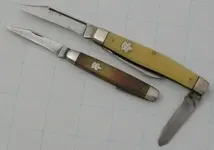This is definitely a switchblade knife. I don't think the handles are bone. From the looks of the tearing and shrinking, I'd say its celluloid, an early type of plastic. you can test this...break off a little piece of the handle and hold it with a tweezers. If it burns well and sizzles, sends up black streams of smoke, its plastic. As was pointed out before, the hole in the handle is a dead give-away for a switchblade. The part you're seeing is where the 'safety' switch was...a sliding lever that prevented the button from being pressed. The 'fishtail' design at the butt end is also a strong indication, as many of the inexpensive knives of this type had this design. It wouldn't date any newer than 1958, as that's when Federal law came in and restricted them (dumb legislation, in my opinion...).
I would say this knife dates anywhere from the '30's to the 50's, as the designs changed little over that time period. If you decide to remove the corrosion, and check out the blade, I'd bet it was made by Shrade or or one of its spin off companies, such as Imperial or Colonial. If the blade is sound enough, you can scrape or sand the tang ( right below where the edge stops) and sometimes make out the brand name. Also, you might want to scrape the liners (the metal part under the handle) to see if its brass. Older models used brass, newer ones, stamped steel. I can't tell from the picture if the liners are actually rusted or just have picked up corrosion from the blade.
Switchblades have been around a long time (hundreds of years) but this variety is definitely 20th century.
Its still a cool find, though!

Knipper







 ?But your opinion is as good as anyone else's.It's just a guessing game at this stage.
?But your opinion is as good as anyone else's.It's just a guessing game at this stage.
